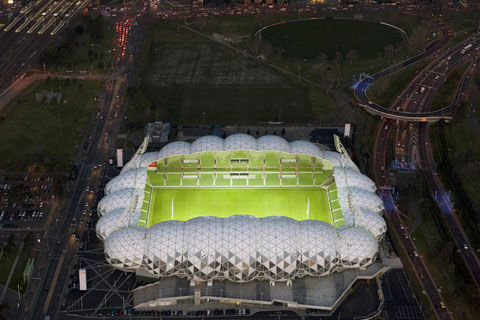Commendation LSAA 2018 Design Awards
APPLICATION OF PROJECT:
Al-fresco canopies over street area for hospitality and retail for the Pacific Bondi mixed use development.
PROJECT DESCRIPTION:
An architecturally styled pair of al-fresco canopy covers for the hospitality area of the Pacific directly facing Bondi Beach, designed to reflect the beach front environment with a form chosen to evocate waves and the ocean. The structures were envisioned to generate a different look from traditional al-fresco umbrellas, awnings and canopies to compliment the seaside position and included infrared heaters and white LED up-lighting to add warmth and atmosphere for night time use.
DESIGN / FABRICATION / INSTALLATION BRIEF
The aim of this project was to provide shelter for outdoor dining clientele at the licensed hospitality businesses of the Bondi Pacific mixed-use development. The structure needed to provide shelter from sun and rain while still allowing room for pedestrian traffic. The client wanted the canopies to be different from the usual umbrella or awning type al-fresco designs to increase the visual impact and attraction of their development. The position of the structure gives views across the iconic Bondi Beach and was therefore designed with “wave-like” perimeter edges and lightweight tree-like lattice columns. Adequate drainage facilities were required for run-off to be directed to the street trees. The design needed to take into account both wind ratings and the potential for corrosion from the seaside position. The location has high pedestrian use and installation had to occur while allowing for minimal disruption to pedestrian access.
STRUCTURAL SYSTEMS
A rigid perimeter frame supports the fabric canopy, this frame is supported by extremely lightweight lattice columns made of four elements. The column design was a key architectural requirement; the support of the edge beams needed to be designed to have an extremely minimal form. In order to maintain support to the edge beam and to minimize edge beam sizing, 4 braces were required from the column to the edge beam. It was proposed at an early stage to combine the edge beam support brace with the column to create a single member, reducing a connection and enhancing the visual impact of the structure. To resist these columns spreading apart a circular ring beam is used to the tie them together at the column head; this ring beam serves a dual purpose as it also supports lighting and heating elements included for patron comfort.
Structurally this tie combines the 4 lightweight columns into a much more rigid composite frame system and increases the in plane stability at the upper canopy level.
MATERIALS
For this project the client was concerned about maintenance and longevity of the installed products, particularly given its highly prominent location. PVC fabrics coated with an additional TiO2 layer for additional self cleaning properties were presented and ultimately one of Taiyo Kogyo’s materials, PSS200, was chosen for the project.
The use of a material with a titanium dioxide coating has reduced the frequency of cleaning required by the client through the project lifecycle and will result in a much longer lasting white finish than typical PVC fabrics would provide.
FABRICATION
TiO2 PVC fabrics are generally weldable on the underside only; considerable care needs to be given to the welding details to ensure that lap welds can be utilized effectively. Of particular attention is where welds meet edges and doublers, and scalloping of overlapping areas was combined with standard PVC doublers to ensure fabrication details could be welded appropriately. To ensure that the proposed fabric patterns could be fabricated, scaled down paper templates of the proposed patterns were plotted first and tested by hand to verify the design decisions made.
The extensive use of curved edge beams and the proposed lightweight and rolled columns led to concerns about the fabrication tolerances presented in rolling steelwork. To overcome this risk we undertook full trial assembly of steelwork in the fabricators facility and ensured that the final steelwork assemblies matched the theoretical design. Fabrication of the membrane was placed on hold until this could be verified.
COLLABORATION, CONSTRUCTION AND MAINTENANCE
Understanding and controlling the risk of fabrication tolerances was a key risk of this project. Strong collaboration between the designers and steel fabricator and the use of trial assemblies prior to accepting steelwork was vital to the successful delivery.
The installation supervisor participated in the trial assembly install in order to perfect the install methodology. Following the trial assembly, improvements to the install methodology were made to save time in the final install and minimize the impact the site works caused to the adjacent road and pavements.
Footings needed to be installed prior to paving works occurring with the steel and fabric installation occurring later. Placement of the footings was extremely critical for tolerances as the complex geometrical design would have been extremely difficult to site modify. Our installers visited site prior to pouring to verify that the as set-out positions and levels were accurate, giving the whole project team confidence that the future installation works would run as planned.
Credits
Entrant: MakMax Australia
Role played by Entrant: Designer, Engineer, Fabricator, Installer
Location: Sydney, NSW Completed: December 2017
Client: Currenti Constructions Pty Ltd for Rebel Property Pty Ltd
Architect: PTW Architects and context Landscape Design






